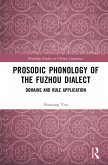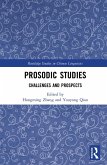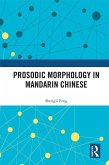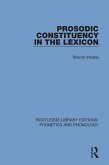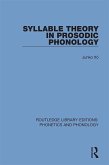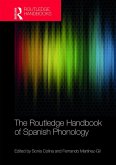

Alle Infos zum eBook verschenken

- Format: PDF
- Merkliste
- Auf die Merkliste
- Bewerten Bewerten
- Teilen
- Produkt teilen
- Produkterinnerung
- Produkterinnerung

Hier können Sie sich einloggen

Bitte loggen Sie sich zunächst in Ihr Kundenkonto ein oder registrieren Sie sich bei bücher.de, um das eBook-Abo tolino select nutzen zu können.
Prosodic Phonology of the Fuzhou Dialect: Domains and Rule Application is the first attempt to conduct a comprehensive analysis of the Fuzhou phonological system from the perspective of prosodic phonology.
It addresses the following issues: What prosodic constituents exist in the Fuzhou dialect and what kinds of roles they play in the Fuzhou phonological system; how to define the domain formation of these prosodic constituents in the Fuzhou dialect; what kinds of Fuzhou phonological phenomena make crucial reference to these prosodic constituents as the domain of application; and what…mehr
- Geräte: PC
- mit Kopierschutz
- eBook Hilfe
![Prosodic Phonology of the Fuzhou Dialect (eBook, ePUB) Prosodic Phonology of the Fuzhou Dialect (eBook, ePUB)]() Shuxiang YouProsodic Phonology of the Fuzhou Dialect (eBook, ePUB)42,95 €
Shuxiang YouProsodic Phonology of the Fuzhou Dialect (eBook, ePUB)42,95 €![Prosodic Studies (eBook, PDF) Prosodic Studies (eBook, PDF)]() Prosodic Studies (eBook, PDF)42,95 €
Prosodic Studies (eBook, PDF)42,95 €![Prosodic Morphology in Mandarin Chinese (eBook, PDF) Prosodic Morphology in Mandarin Chinese (eBook, PDF)]() Shengli FengProsodic Morphology in Mandarin Chinese (eBook, PDF)42,95 €
Shengli FengProsodic Morphology in Mandarin Chinese (eBook, PDF)42,95 €![The Shetland Dialect (eBook, PDF) The Shetland Dialect (eBook, PDF)]() Peter SundkvistThe Shetland Dialect (eBook, PDF)42,95 €
Peter SundkvistThe Shetland Dialect (eBook, PDF)42,95 €![Prosodic Constituency in the Lexicon (eBook, PDF) Prosodic Constituency in the Lexicon (eBook, PDF)]() Sharon InkelasProsodic Constituency in the Lexicon (eBook, PDF)24,95 €
Sharon InkelasProsodic Constituency in the Lexicon (eBook, PDF)24,95 €![Syllable Theory in Prosodic Phonology (eBook, PDF) Syllable Theory in Prosodic Phonology (eBook, PDF)]() Junko ItôSyllable Theory in Prosodic Phonology (eBook, PDF)33,95 €
Junko ItôSyllable Theory in Prosodic Phonology (eBook, PDF)33,95 €![The Routledge Handbook of Spanish Phonology (eBook, PDF) The Routledge Handbook of Spanish Phonology (eBook, PDF)]() The Routledge Handbook of Spanish Phonology (eBook, PDF)46,95 €
The Routledge Handbook of Spanish Phonology (eBook, PDF)46,95 €-
-
-
It addresses the following issues: What prosodic constituents exist in the Fuzhou dialect and what kinds of roles they play in the Fuzhou phonological system; how to define the domain formation of these prosodic constituents in the Fuzhou dialect; what kinds of Fuzhou phonological phenomena make crucial reference to these prosodic constituents as the domain of application; and what implications does the study of the Fuzhou phonological system have for the prosodic phonology theory.
This book is a valuable text for students and scholars in the field of Chinese dialectology, Min dialects, prosodic phonology, and phonology-morphosyntax interface.
Dieser Download kann aus rechtlichen Gründen nur mit Rechnungsadresse in A, B, BG, CY, CZ, D, DK, EW, E, FIN, F, GR, HR, H, IRL, I, LT, L, LR, M, NL, PL, P, R, S, SLO, SK ausgeliefert werden.
- Produktdetails
- Verlag: Taylor & Francis eBooks
- Seitenzahl: 262
- Erscheinungstermin: 31. März 2020
- Englisch
- ISBN-13: 9780429521034
- Artikelnr.: 58988244
- Verlag: Taylor & Francis eBooks
- Seitenzahl: 262
- Erscheinungstermin: 31. März 2020
- Englisch
- ISBN-13: 9780429521034
- Artikelnr.: 58988244
- Herstellerkennzeichnung Die Herstellerinformationen sind derzeit nicht verfügbar.
[ki0] 4.2.2 Adjective reduplication markers
[si
213],
[sei
23], and
[luö23] 4.2.3 Aspect markers 4.2.4 Post-verbal particles 4.2.5 Locative marker
[l
0] 4.2.6 Recursive clitic group with enclitics 4.2.7 Summary 4.3 Phonological phenomena within Type A clitic group in the Fuzhou dialect 4.3.1 TS within Type A clitic group 4.3.2 FC within Type A clitic group 4.3.3 CL within Type A clitic group 4.3.4 Summary 4.4 Violation of SLH within Type A clitic group 4.5 Summary 5 Phonological phrase: domain of phrasal-level rule application in the Fuzhou dialect 5.1 Application of TS at the phrasal level 5.1.1 The nature of the problem 5.1.2 Previous analyses 5.1.3 Which is a better solution: RBA or EBA? 5.1.4 An alternative approach to phonological phrasing in the Fuzhou dialect 5.1.5 Summary 5.2 Application of FC at the phrasal level 5.3 Application of CL at the phrasal level 5.4 Summary 6 Proclitics and Type B clitic group in the Fuzhou dialect 6.1 Proclitics in the Fuzhou dialect and their morphosyntactic functions 6.1.1 Progressive aspect marker
[l
31] 6.1.2 Auxiliary verbs
[sei242] and
[
ou242] 6.1.3 Prepositions
[tsuö44] and
[ky
44] 6.1.4 Recursive clitic group with proclitics 6.1.5 Summary 6.2 Phonological phenomena within Type B clitic group in the Fuzhou dialect 6.2.1 TS within Type B clitic group 6.2.2 FC within Type B clitic group 6.2.3 CL within Type B clitic group 6.2.4 Summary and discussion 6.3 Violation of SLH within Type B clitic group 6.4 Summary 7 Intonational phrase in Fuzhou: variability in domain formation and rule application 7.1 Definition and restructuring of the intonational phrase in the Fuzhou dialect 7.1.1 Definition of the intonational phrase in the Fuzhou dialect 7.1.2 Restructuring of the intonational phrase in the Fuzhou dialect 7.1.3 Summary 7.2 Rule application within the intonational phrase in the Fuzhou dialect 7.2.1 Introduction: variability in
-domain rule application across languages 7.2.2 Blocking of phonological rules across
boundaries in the Fuzhou dialect 7.2.3 Optional rule application within intonational phrase in the Fuzhou dialect 7.2.4 Summary 7.3 Summary 8 Concluding remarks 8.1 Prosodic domains and rule application in the Fuzhou dialect 8.2 Theoretical issues regarding prosodic phonology 8.3 Future research References Index
[ki0] 4.2.2 Adjective reduplication markers
[si
213],
[sei
23], and
[luö23] 4.2.3 Aspect markers 4.2.4 Post-verbal particles 4.2.5 Locative marker
[l
0] 4.2.6 Recursive clitic group with enclitics 4.2.7 Summary 4.3 Phonological phenomena within Type A clitic group in the Fuzhou dialect 4.3.1 TS within Type A clitic group 4.3.2 FC within Type A clitic group 4.3.3 CL within Type A clitic group 4.3.4 Summary 4.4 Violation of SLH within Type A clitic group 4.5 Summary 5 Phonological phrase: domain of phrasal-level rule application in the Fuzhou dialect 5.1 Application of TS at the phrasal level 5.1.1 The nature of the problem 5.1.2 Previous analyses 5.1.3 Which is a better solution: RBA or EBA? 5.1.4 An alternative approach to phonological phrasing in the Fuzhou dialect 5.1.5 Summary 5.2 Application of FC at the phrasal level 5.3 Application of CL at the phrasal level 5.4 Summary 6 Proclitics and Type B clitic group in the Fuzhou dialect 6.1 Proclitics in the Fuzhou dialect and their morphosyntactic functions 6.1.1 Progressive aspect marker
[l
31] 6.1.2 Auxiliary verbs
[sei242] and
[
ou242] 6.1.3 Prepositions
[tsuö44] and
[ky
44] 6.1.4 Recursive clitic group with proclitics 6.1.5 Summary 6.2 Phonological phenomena within Type B clitic group in the Fuzhou dialect 6.2.1 TS within Type B clitic group 6.2.2 FC within Type B clitic group 6.2.3 CL within Type B clitic group 6.2.4 Summary and discussion 6.3 Violation of SLH within Type B clitic group 6.4 Summary 7 Intonational phrase in Fuzhou: variability in domain formation and rule application 7.1 Definition and restructuring of the intonational phrase in the Fuzhou dialect 7.1.1 Definition of the intonational phrase in the Fuzhou dialect 7.1.2 Restructuring of the intonational phrase in the Fuzhou dialect 7.1.3 Summary 7.2 Rule application within the intonational phrase in the Fuzhou dialect 7.2.1 Introduction: variability in
-domain rule application across languages 7.2.2 Blocking of phonological rules across
boundaries in the Fuzhou dialect 7.2.3 Optional rule application within intonational phrase in the Fuzhou dialect 7.2.4 Summary 7.3 Summary 8 Concluding remarks 8.1 Prosodic domains and rule application in the Fuzhou dialect 8.2 Theoretical issues regarding prosodic phonology 8.3 Future research References Index

